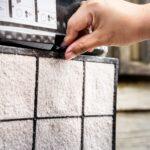Excessive humidity is no fun. It’s sticky, it’s uncomfortable, and it messes up our hair. But jokes aside, excessive humidity left unaddressed in your home causes property damage and health issues. So with swamp season descending on us, you may be asking, do I need a whole-home dehumidifier?
Today we’re here to help you answer that question. In this blog post, we will discuss the following:
- What is a Whole-Home Dehumidifier?
- How Does a Whole-Home Dehumidifier Work?
- The Advantages of a Whole-Home Dehumidifier over Central Air Dehumidification
- Signs that Your Home’s Humidity is Too High
- The Risks of Foregoing a Whole-Home Dehumidifier
- The Costs of a Whole-Home Dehumidifier
After you review this post, you should have a good idea of whether a whole-home dehumidifier is right for you. Let’s get to it.
What is a Whole-Home Dehumidifier?
A whole-home dehumidifier is an HVAC product that removes excess moisture from your indoor air and maintains optimal humidity levels throughout your home. An optimal indoor humidity level — one that is healthy for you and your house — is around 40-55%.
A whole-home dehumidifier isn’t too exciting to look at. It is basically a rectangular box. Its height can be anywhere from two to four feet, and its width and depth range from one to two feet each. The outer casing of a whole-home dehumidifier is made of sturdy, corrosion-resistant materials like metal or high-quality plastic.
Inside the dehumidifier are several components that work together to remove moisture from the air, including evaporator coils, condenser coils, a fan, and a condensate drain pan.
Unlike portable dehumidifiers, which reduce moisture in only one room, a whole-home dehumidifier reduces the moisture in all your rooms. It is connected to your existing central HVAC system, typically at the return air duct. This allows the dehumidifier to draw in air from all the areas of your home and treat it.
How Does a Whole-Home Dehumidifier Work?
Here is the step-by-step process by which whole-home dehumidifiers remove the excess moisture from your indoor air:
Air Intake
The whole-home dehumidifier is connected to the ductwork of your HVAC system. It has a dedicated intake valve that draws in indoor air from various areas of your home.
Filtration
As the dehumidifier draws in air, it passes that air through a filter. The filter removes dust, particles, and other contaminants from the air.
Cooling and Dehumidification
The dehumidifier then directs the warm, humid air over its cold evaporator coils. This causes the moisture in the air to condense onto the coils’ surface. The condensation process removes the air’s excess moisture.
Condensate Collection
The condensed moisture drips down from the evaporator coils into a condensate drain pan, which collects the water.
Drainage
Different whole-home dehumidifiers have different draining setups. Some dehumidifiers have a built-in pump system that removes the collected water through a drain outlet. Others rely on a gravity-based drainage system, where the drain pan connects to a hose that empties into a floor drain or a sump pump. Sometimes an external condensate pump may remove the water from your home.
Air Reheating
After the dehumidifier extracts the moisture from the air, the air is cold and needs to be reheated to a comfortable temperature for your home. The dehumidifier reheats the cold air by passing it over the warm condenser coils.
Air Distribution
The dehumidifier then sends the drier and temperate air back into your home through your HVAC system’s ductwork. This air mixes with the existing air in your home and helps lower the overall humidity levels.
The Advantages of a Whole-Home Dehumidifier over Central Air Dehumidification
Central air conditioners deliver dehumidified air as a by-product of delivering cool air. As they absorb heat from the air, they extract some of its moisture, too. But air conditioners are designed primarily for cooling. Their focus is air temperature.
Whole-home dehumidifiers, on the other hand, are designed specifically to reduce humidity in indoor air and maintain a narrow range of humidity levels throughout a home. Their focus is moisture.
Whole home dehumidifiers operate independently of your air conditioning system. This means they can dehumidify the air no matter what the outdoor temperature is, and whether you’re running your air conditioner or not. A whole-home dehumidifier dries the air without over-cooling it.
Signs that Your Home’s Humidity is Too High
If you notice any of the following, your home’s air may contain excess moisture that a whole-home dehumidifier can help remove:
- Persistent musty odors.
- Frequent or even permanent window fog (this is from condensation that collects on windows), or condensation on other surfaces.
- Mold or mildew growth in bathrooms, basements, or other areas with low ventilation, like closets.
- Allergies, asthma, or other respiratory issues.
- Warping and buckling in wood furniture or flooring.
- Spiders, bug infestations, and cobwebs.
- Water stains on walls or ceilings.
Another sign that you could benefit from a whole-home dehumidifier is if you’re constantly running a portable dehumidifier somewhere, like in your basement. A portable dehumidifier does a good job of removing moisture from a contained area, but it is inconvenient to run. You must empty its water reservoir constantly and clean it thoroughly to prevent mold growth inside the unit. Plus, a portable dehumidifier is an electricity hog — it uses more electricity than a whole-home dehumidifier. More on that in a bit!
Risks of Foregoing a Whole-Home Dehumidifier
Neglecting to address high humidity levels in your home can damage both your property and your health. Excessive moisture in your indoor air causes:
- The growth of mold and mildew, which warps wood and eventually rots it. This leads to structural problems and requires costly, time-consuming home repairs like mold remediation and renovations.
- Unpleasant smells throughout your home.
- Damp indoor air that triggers allergies and respiratory problems.
- An ideal environment for pest infestations.
- Discomfort. For humans, humidity equals heat. The higher the humidity in your home, the hotter you’ll feel, regardless of the temperature.
Costs of a Whole-Home Dehumidifier
The total cost of a whole-home dehumidifier is determined by four things: the product you buy, its installation, the power it uses to run, and its maintenance.
Cost Factor #1: Equipment
The price of the dehumidifier itself depends on its capacity (meaning the amount of water it can remove per day) and its features. Given the range of capacities and features, the price of a whole-home dehumidifier can range from about $1,500 to $3,000 or more.
Base models have a smaller capacity, measured in pints per day. They are suitable for smaller homes or regions where humidity is less frequent. Base models also tend to have manual controls and limited settings.
Premium models have a larger capacity, measured in gallons per day. They are suitable for larger homes or regions where high humidity is a challenge. Premium models typically have advanced digital sensors and a wider range of programmable settings.
Cost Factor #2: Installation
You could install a whole-home dehumidifier yourself, but because it must be safely integrated with your home’s HVAC system, it’s a job better left to an HVAC pro. A professional can help you decide what model works best with your HVAC brand, your ductwork, and your home’s size and layout.
Plus, a whole-home dehumidifier introduces water capture into your home. This technology is fantastic when it works properly and disastrous when it doesn’t. An improperly installed dehumidifier can let water leak into your home’s walls and floors. This will cause mold growth that you may not see until it has grown and spread to dangerous levels.
Installation costs for a whole-home dehumidifier vary depending on the home and the complexity of the job. But roughly speaking, labor for whole-home dehumidifier installation can range from $1,000 to $2,000 or more.
Cost Factor #3: Operation
The cost of running a whole-home dehumidifier is relatively low:
- The electricity cost for operating a whole-home dehumidifier ranges from $15 to $25 per month, which translates to about $180 to $300 per year. Of course, this cost depends on the model, its energy rating, usage patterns, and where you live.
- A whole-home dehumidifier consumes less electricity than a portable dehumidifier, which must run constantly and can cost nearly $2 per day. That’s nearly $60 per month, or $720 per year, to treat the air in only one room.
- A whole-home dehumidifier also consumes less energy than your air conditioning system. A typical whole-home dehumidifier uses about 4 kWh of electricity per day, and energy-efficient ones use even less. Meanwhile, a typical air conditioner uses about 55 kWh of electricity per day.
- The features of a whole-home dehumidifier often include energy-saving settings and automatic power management controls. This means it can run only when necessary, rather than constantly.
Not only is a whole-home dehumidifier inexpensive to run, but it saves you money in other ways too:
- With its filtration capabilities, a whole-home dehumidifier helps protect your HVAC equipment from dirt and debris. This keeps your furnace and air conditioner running longer and more efficiently.
- With a whole-home dehumidifier, you can set your air conditioner’s thermostat to run a degree or two higher and still feel just as cool. This is because when air is less heavy and sticky, it feels cooler.
Cost Factor #4: Maintenance
A whole-home dehumidifier requires very little upkeep besides periodic filter cleaning or replacement, which your HVAC contractor can do during a regular maintenance visit.
The cost of a replacement filter is $20 to $50, on average. This is in addition to the cost of the maintenance visit. Your whole-home dehumidifier will need a filter replacement about once per year.
_____________
Are you thinking of installing a whole-home dehumidifier? It can be amazing for your indoor air quality in our hot and sticky Pittsburgh summers. At Kowalski Heating, Cooling, and Plumbing, we’ll help you determine if your home could benefit from a whole-home dehumidifier. We’ll also make sure you get one that suits your needs and budget. Our estimates are free, and our work is pristine.
Call or text us at 412-952-5923. You can also contact us via our website at any time. We look forward to serving you!





